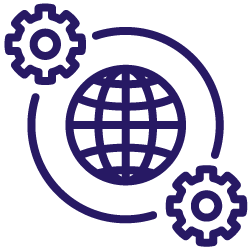In today’s ever-evolving SEO realm, the dynamic interplay between human insight and automated tools has become crucial for achieving digital success.
As mid-level technical SEO practitioners deeply engaged in data analysis and tool implementation, the ongoing debate about automation’s role in our field has reached a crescendo.
While the allure of streamlined workflows and improved efficiency through automation is undeniable, there’s a looming concern about potential downsides that warrants a closer examination.
This article takes you on an engaging exploration of the merits and drawbacks of automation within the SEO domain. Get ready for a journey through the intricate landscape where human expertise intersects with the capabilities of algorithms and machine learning.
Our aim is to conduct a thorough analysis of the benefits and pitfalls, providing you, the savvy data-driven SEO professional, with the insights needed to navigate this ever-changing landscape wisely.
Whether you’re utilizing tools regularly or cautiously stepping into the automation realm, this discussion aims to equip you with a well-rounded perspective for making informed decisions.
Why is automation useful in SEO?
SEO is undeniably a multifaceted domain that demands continuous learning, perpetual upskilling, and, above all, a reliance on data and the appropriate tools. Mastering the art of working with the correct tools and discerning their optimal application is paramount.
Let’s address the fundamental aspect of this article: automation is an indispensable component in SEO.
Single-handedly trying to monitor seasonality, keep pace with algorithmic shifts, analyze server log files, and strategize on where to concentrate further efforts is simply unattainable. It should not be a solo performance; rather, it necessitates collaborative teamwork harmonized with apt data tools.
SEO automation helps you manage the time-consuming tasks and frees up time to focus on the potentially more strategic aspects of our jobs. It can help with data collection and analysis and scale projects for your website.
Drawing from my eight-year tenure within the SEO sphere, I’ve utilized computer science and engineering techniques to navigate its complexities. Through this experience, I’ve gleaned the intricacies of effectively addressing SEO challenges.
My journey at the juncture of digital marketing and technology has provided insights into both successes and errors encountered by myself and my peers while leveraging data tools to steer our problem-solving endeavors.
[Ebook] Automating SEO with Oncrawl
Understanding the different workflows of engineers and marketers
Before we address where automation may prove more useful for marketers vs engineers and vice versa, the first thing that we need to understand is how engineers and marketers work and think.
In the realm of business, two primary functions stand out: production and sales. Consequently, the fundamental perspectives in business are rooted in production and marketing.
Typically, production is the domain of engineering teams. These teams rely on scientific principles and employ statistical evidence and numerical data to validate the viability of projects. Their work is amplified through scaling operations and reducing costs.
On the other hand, marketers thrive when it comes to foreseeing market demands by innovating products, services, and experiences that cater to these needs. They are less implicated in the production aspect, and thus heavily rely on engineering teams to bring solutions to market and build compelling cases for testing.
In broad strokes, marketers are driven by innovation while engineers are oriented towards efficiency. This dichotomy often leads to a divergence in priorities regarding what processes to automate and where it would be beneficial to scale certain tasks.
Where do automation priorities diverge and what are their pros and cons?
For marketers
Let’s take a look at SEO forecasting. An engineer working alone on developing a forecasting model will create an almost perfect forecasting solution for predicting potential SEO traffic, click-through rate, or any other metrics deemed important.
However, this would not be possible without the SEO (or marketing) understanding of seasonality, keyword and intent evolution, user demand and so on.
A problem well-defined is a problem half-solved: it’s easy to pick the right forecasting model once you know how everything should work in the initial planning.
Conversely, if marketers (or inexperienced engineers) were left to the forecasting task, they will likely turn to one of the following automated solutions:
Pre-built tools
Utilizing prebuilt tools for forecasting can be advantageous in certain cases when the marketer is experienced enough to know the pros and cons of using these tools. However, in reality, it can be easy to overlook the intricate workings behind them.
One may not delve into understanding the underlying mechanisms: the type of data they collect, whether they utilize or share it with third-party data providers, how specific metrics are computed, or the selection of models for forecasting and the rationale behind those choices. This is certainly something you should keep in mind when employing a pre-built solution.
The spreadsheet solution
Employing classic spreadsheets for forecasting presents another alternative where you know exactly where your data is and what is being done with it. You can customize it to fit your needs precisely and subsequently automate with the necessary apps scripts.
Nonetheless, in practical application, it falls short when it comes to accommodating diverse regions. For instance, considering specific regional events or holiday patterns that could significantly impact forecasts is not always top of mind.
Moreover, current Excel forecasting capabilities lack the integration of advanced machine learning (ML) and data science models for robust statistical analysis or SEO forecasting. This limitation complicates the process further, highlighting the challenges faced in this area.
Building an automated solution
Developing an automated solution by using Facebook’s Prophet, ARIMA or other model can be great because they are reliable when you know the engineering nitty-gritty details on how they work. But, it’s definitely not feasible without the necessary technical skills and the business acumen to plan the solution.
For engineers
As mentioned previously, engineers are primarily focused on scaling operations and one area in which automation may prove useful is in tracking web performance. With more and more information to track on a regular basis, conducting full site audits is something that doesn’t happen as often any more.
However, using tools for site monitoring as an automated process in your workflow helps engineers save time and energy.
Such tools can identify issues such as broken links, crawl errors, and other technical issues that may affect a site’s performance in search engine rankings. This allows engineers to address these issues promptly and maintain a well-optimized website.
The list doesn’t stop there, automation can also prove to be a time saver in regards to keyword research, monitoring and reporting on traffic sources and the efficiency of SEO strategies as well as identifying quality backlink opportunities.
In all things mentioned, let’s not even talk about the persistent Google updates and how they would have an impact on your automation solutions – they represent a whole other layer of complexity that we would need to account for.
Where else can automation be useful?
Data categorization, or keyword clustering, is another perfect example of where automation can be useful. I’ve tried developing my own solutions in Python and also spent a fair amount of time testing existing solutions in different setups and here’s what I’ve learned:
- You can use prebuilt tools to perform the clustering. They are usually paid but this is OK as long as the tool is providing all the necessary info for the user. E.g. which algorithm is used to cluster 1,000 words and which one is used to cluster 1,000,000 words. From experience, these two should not be the same because the vectorization of different amounts of queries affects which algorithm should be picked.
- You can use some online, free tools to perform the clustering, but again, you can never guarantee how your data will be used and they can also be quite limiting. You might need to cluster more data than allowed or you can quickly spend the free credits provided and get attached to a solution that is not reliably accessible in the long run.
- Finally, you can use some Python scripts that the SEO community is developing but in practice, I’ve observed the pattern of bad coding practices including a limited use of object-oriented code principles, a lack of proper code testing, an absence of documentation and so on. All of these three can make these Python scripts developed by the SEO community unreliable to use.
What should I do to develop a bullet-proof solution for SEO data analysis and general SEO tooling?
Great question! Even though I always try to automate working in collaboration with my data engineers or data scientists, I do recommend relying on a trusted digital partner that invests regularly in upgrading their SEO tooling and automation of SEO processes.
For me it’s important that this SEO provider is in line with my values and how I see the future of SEO: automated, with a human-in-the-loop approach and innovative.
One such example is Oncrawl. In the realm of competitive SEO tools, Oncrawl emerges as an exceptional solution that effortlessly combines technical SEO insights that create the foundation needed to build strategic recommendations or inform your next steps.
This integration empowers both SEO professionals and businesses to attain remarkable visibility on search engines. Unlike conventional SEO tools that tend to concentrate solely on technical elements, Oncrawl raises the bar by advancing SEO to a strategic level.
It allows users to acquire a comprehensive grasp of their website’s SEO performance, thereby pinpointing opportunities to optimize for enhanced search visibility.
Final thoughts
Engineers and marketers alike play crucial roles in the successful implementation of SEO automation. While marketers bring their expertise in understanding user behavior and search intent, engineers provide the technical skills to develop and implement automation tools effectively.
Playtesting is essential to ensure SEO automation tools are performing as expected and delivering positive results. By carefully testing different configurations and metrics, marketers and engineers can optimize automation tools for maximum impact.
Data also plays a central role in the successful implementation of SEO automation and understanding data sources, data computation methods, and statistical analysis techniques is crucial for making informed decisions about automation strategy and evaluating the effectiveness of automation tools.
By combining their expertise and data-driven approach, engineers and marketers can create a powerful synergy that drives SEO success. Through collaboration and a shared understanding of automation principles, they can automate tedious tasks, optimize resource utilization, and achieve better overall SEO performance.
In summary, SEO automation is not about replacing human expertise but rather augmenting it. By leveraging automation tools effectively, marketers and engineers can focus on higher-level strategic planning and decision-making, while allowing automation to handle the more routine and time-consuming tasks.


